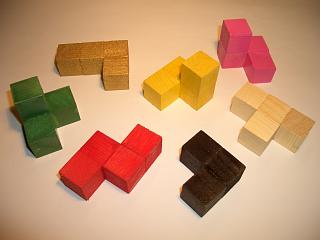|
Tetromino
A tetromino is a geometric shape composed of four squares, connected orthogonally (i.e. at the edges and not the corners). Tetrominoes, like dominoes and pentominoes, are a particular type of polyomino. The corresponding polycube, called a tetracube, is a geometric shape composed of four cubes connected orthogonally. A popular use of tetrominoes is in the video game ''Tetris'' created by the Soviet game designer Alexey Pajitnov, which refers to them as tetriminos. The tetrominoes used in the game are specifically the one-sided tetrominoes. Types of tetrominoes Free tetrominoes Polyominos are formed by joining unit squares along their edges. A free polyomino is a polyomino considered up to congruence. That is, two free polyominos are the same if there is a combination of translations, rotations, and reflections that turns one into the other. A free tetromino is a free polyomino made from four squares. There are five free tetrominoes. The free tetrominoes have the following sy ... [...More Info...] [...Related Items...] OR: [Wikipedia] [Google] [Baidu] |
Tetris
''Tetris'' () is a puzzle video game created in 1985 by Alexey Pajitnov, a Soviet software engineer. In ''Tetris'', falling tetromino shapes must be neatly sorted into a pile; once a horizontal line of the game board is filled in, it disappears, granting points and preventing the pile from overflowing. Over 200 versions of ''Tetris'' have been published by numerous companies on more than 65 platforms, often with altered game mechanics, some of which have become standard over time. To date, these versions of ''Tetris'' collectively serve as the second-best-selling video game series with over 520 million sales, mostly on mobile devices. In the 1980s, Pajitnov worked for the Computing Center of the Academy of Sciences, where he programmed ''Tetris'' on the Elektronika 60 and adapted it to the IBM PC with the help of Dmitry Pavlovsky and Vadim Gerasimov. Floppy disk copies were distributed freely throughout Moscow, before spreading to Eastern Europe. Robert Stein of Andro ... [...More Info...] [...Related Items...] OR: [Wikipedia] [Google] [Baidu] |
Polyomino
A polyomino is a plane geometric figure formed by joining one or more equal squares edge to edge. It is a polyform whose cells are squares. It may be regarded as a finite subset of the regular square tiling. Polyominoes have been used in popular puzzles since at least 1907, and the enumeration of pentominoes is dated to antiquity. Many results with the pieces of 1 to 6 squares were first published in '' Fairy Chess Review'' between the years 1937 and 1957, under the name of "dissection problems." The name ''polyomino'' was invented by Solomon W. Golomb in 1953, and it was popularized by Martin Gardner in a November 1960 " Mathematical Games" column in ''Scientific American''. Related to polyominoes are polyiamonds, formed from equilateral triangles; polyhexes, formed from regular hexagons; and other plane polyforms. Polyominoes have been generalized to higher dimensions by joining cubes to form polycubes, or hypercubes to form polyhypercubes. In statistical physics, t ... [...More Info...] [...Related Items...] OR: [Wikipedia] [Google] [Baidu] |
Free Polyomino
A polyomino is a plane geometric figure formed by joining one or more equal squares edge to edge. It is a polyform whose cells are squares. It may be regarded as a finite subset of the regular square tiling. Polyominoes have been used in popular puzzles since at least 1907, and the enumeration of pentominoes is dated to antiquity. Many results with the pieces of 1 to 6 squares were first published in '' Fairy Chess Review'' between the years 1937 and 1957, under the name of "dissection problems." The name ''polyomino'' was invented by Solomon W. Golomb in 1953, and it was popularized by Martin Gardner in a November 1960 "Mathematical Games" column in ''Scientific American''. Related to polyominoes are polyiamonds, formed from equilateral triangles; polyhexes, formed from regular hexagons; and other plane polyforms. Polyominoes have been generalized to higher dimensions by joining cubes to form polycubes, or hypercubes to form polyhypercubes. In statistical physics, the stud ... [...More Info...] [...Related Items...] OR: [Wikipedia] [Google] [Baidu] |
Pentomino
A pentomino (or 5-omino) is a polyomino of order 5; that is, a polygon in the Plane (geometry), plane made of 5 equal-sized squares connected edge to edge. The term is derived from the Greek word for '5' and "domino". When rotation symmetry, rotations and reflection symmetry, reflections are not considered to be distinct shapes, there are 12 different ''Free polyomino, free'' pentominoes. When reflections are considered distinct, there are 18 ''One-sided polyomino, one-sided'' pentominoes. When rotations are also considered distinct, there are 63 ''Fixed polyomino, fixed'' pentominoes. Pentomino tiling puzzles and games are popular in recreational mathematics. Usually, video games such as ''Tetris'' imitations and Rampart (game), ''Rampart'' consider mirror reflections to be distinct, and thus use the full set of 18 one-sided pentominoes. (Tetris itself uses 4-square shapes.) Each of the twelve pentominoes satisfies the Conway criterion; hence, every pentomino is capable of tilin ... [...More Info...] [...Related Items...] OR: [Wikipedia] [Google] [Baidu] |
Chirality (mathematics)
In geometry, a figure is chiral (and said to have chirality) if it is not identical to its mirror image, or, more precisely, if it cannot be mapped to its mirror image by Rotation (mathematics), rotations and Translation (geometry), translations alone. An object that is not chiral is said to be ''achiral''. A chiral object and its mirror image are said to be enantiomorphs. The word ''chirality'' is derived from the Greek (cheir), the hand, the most familiar chiral object; the word ''enantiomorph'' stems from the Greek (enantios) 'opposite' + (morphe) 'form'. Examples Some chiral three-dimensional objects, such as the helix, can be assigned a right or left handedness, according to the right-hand rule. Many other familiar objects exhibit the same chiral symmetry of the human body, such as gloves and shoes. Right shoes differ from left shoes only by being mirror images of each other. In contrast thin gloves may not be considered chiral if you can wear them wiktionary:inside ou ... [...More Info...] [...Related Items...] OR: [Wikipedia] [Google] [Baidu] |
Alexey Pajitnov
Alexey Leonidovich Pajitnov (born April 16, 1955) is a Russian-American computer engineer and video game designer. He is best known for creating, designing, and developing ''Tetris'' in 1985 while working at the Dorodnitsyn Computing Centre under the Academy of Sciences of the Soviet Union (now the Russian Academy of Sciences). After ''Tetris'' was released internationally in 1987, he released a sequel in 1989, entitled '' Welltris''. In 1991, he moved to the United States and later became a U.S. citizen. In 1996, Pajitnov founded The Tetris Company alongside Dutch video game designer Henk Rogers. Despite the game's high popularity, Pajitnov did not receive royalties from ''Tetris'' prior to this time; the Soviet Union had disintegrated by 1991. Early life Pajitnov was born to Russian parents who were both writers. His father was an art critic and his mother was a journalist who wrote for both newspapers and a film magazine. It was through his parents that Pajitnov gained e ... [...More Info...] [...Related Items...] OR: [Wikipedia] [Google] [Baidu] |
Polyforms
In recreational mathematics, a polyform is a plane (mathematics), plane figure or solid compound constructed by joining together identical basic polygons. The basic polygon is often (but not necessarily) a convex polygon, convex plane-filling polygon, such as a Square (geometry), square or a triangle. More specific names have been given to polyforms resulting from specific basic polygons, as detailed in the table below. For example, a square basic polygon results in the well-known polyominoes. Construction rules The rules for joining the polygons together may vary, and must therefore be stated for each distinct type of polyform. Generally, however, the following rules apply: #Two basic polygons may be joined only along a common edge, and must share the entirety of that edge. #No two basic polygons may overlap. #A polyform must be connected (that is, all one piece; see connected graph, connected space). Configurations of disconnected basic polygons do not qualify as polyforms. #The ... [...More Info...] [...Related Items...] OR: [Wikipedia] [Google] [Baidu] |
Soma Cube
The Soma cube is a mechanical puzzle#Assembly, solid dissection puzzle invented by Danish polymath Piet Hein (scientist), Piet Hein in 1933 during a lecture on quantum mechanics conducted by Werner Heisenberg. Seven different Polycube, pieces made out of unit cubes must be assembled into a 3×3×3 cube. The pieces can also be used to make a variety of other Three-dimensional space, 3D shapes. The pieces of the Soma cube consist of all possible combinations of at most four unit cubes, joined at their faces, such that at least one inside corner is formed. There are no combinations of one or two cubes that satisfy this condition, but one combination of three cubes and six combinations of four cubes that do. Thus, 3 + (6 × 4) is 27, which is exactly the number of cells in a 3×3×3 cube. Of these seven combinations, two are mirror images of each other (see Chirality (mathematics), Chirality). The Soma cube was popularized by Martin Gardner in the September 1958 Mathematical Games ... [...More Info...] [...Related Items...] OR: [Wikipedia] [Google] [Baidu] |
Ancient Greek
Ancient Greek (, ; ) includes the forms of the Greek language used in ancient Greece and the classical antiquity, ancient world from around 1500 BC to 300 BC. It is often roughly divided into the following periods: Mycenaean Greek (), Greek Dark Ages, Dark Ages (), the Archaic Greece, Archaic or Homeric Greek, Homeric period (), and the Classical Greece, Classical period (). Ancient Greek was the language of Homer and of fifth-century Athens, fifth-century Athenian historians, playwrights, and Ancient Greek philosophy, philosophers. It has contributed many words to English vocabulary and has been a standard subject of study in educational institutions of the Western world since the Renaissance. This article primarily contains information about the Homeric Greek, Epic and Classical periods of the language, which are the best-attested periods and considered most typical of Ancient Greek. From the Hellenistic period (), Ancient Greek was followed by Koine Greek, which is regar ... [...More Info...] [...Related Items...] OR: [Wikipedia] [Google] [Baidu] |
Domino
Dominoes is a family of tile-based games played with gaming pieces. Each domino is a rectangular tile, usually with a line dividing its face into two square ''ends''. Each end is marked with a number of spots (also called '' pips'' or ''dots'') or is blank. The backs of the tiles in a set are indistinguishable, either blank or having some common design. The gaming pieces make up a domino set, sometimes called a ''deck'' or ''pack''. The traditional European domino set consists of 28 tiles, also known as pieces, bones, rocks, stones, men, cards or just dominoes, featuring all combinations of spot counts between zero and six. A domino set is a generic gaming device, similar to playing cards or dice, in that a variety of games can be played with a set. Another form of entertainment using domino pieces is the practice of domino toppling. The earliest mention of dominoes is from Song dynasty China found in the text ''Former Events in Wulin'' by Zhou Mi (1232–1298).Lo, Andrew. ... [...More Info...] [...Related Items...] OR: [Wikipedia] [Google] [Baidu] |



